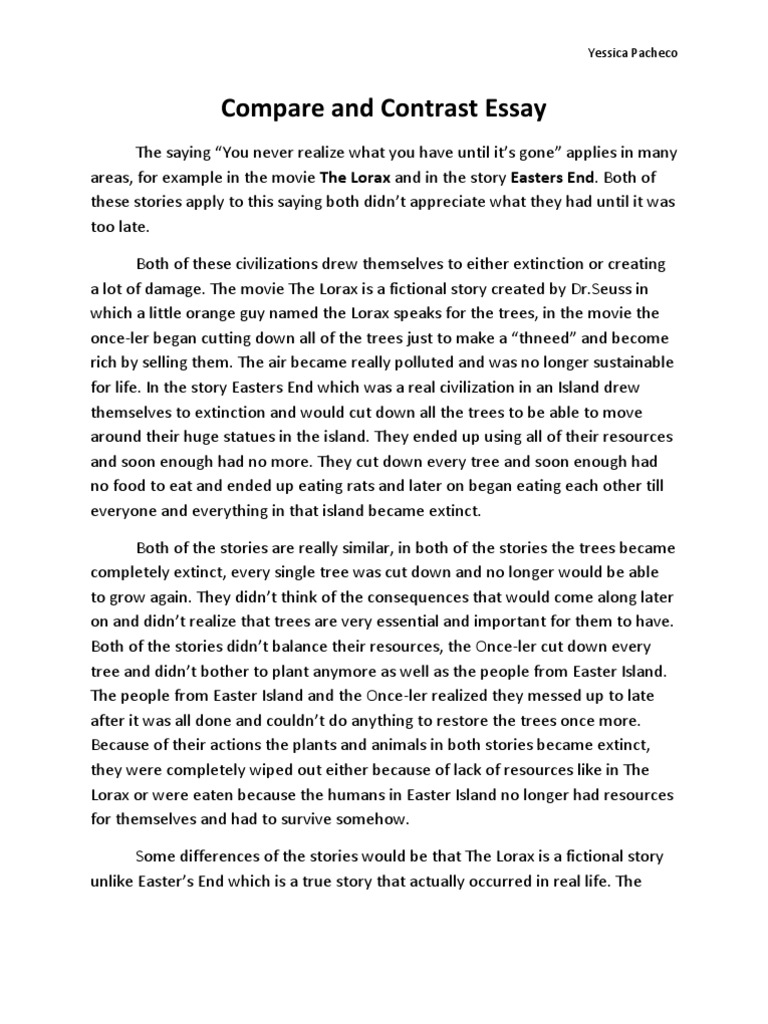
Michel de Montaigne Jun 24, · How to structure a compare-and-contrast essay Block method (subject by subject). The block method is usually divided into paragraphs: a paragraph about one subject Alternating method (point by point). As another option, you can break paragraphs up by a specific topic and issue, and One of the most common is the comparison/contrast essay, in which you focus on the ways in which certain things or ideas—usually two of them—are similar to (this is the comparison) and/or different from (this is the contrast) one another
Comparing and Contrasting – The Writing Center • University of North Carolina at Chapel Hill
By assigning such essays, your instructors are encouraging you to make connections between texts or ideas, engage in critical thinking, and go beyond mere description or summary to generate interesting analysis: when you reflect on similarities and differences, you gain a deeper understanding of the items you are comparing, their relationship to each other, and what is most important about them. Here are a few hypothetical examples:. You may want to check out our handout on understanding assignments for additional tips. Making a Venn diagram or a chart can help you quickly and efficiently compare and contrast two or more things or ideas.
In the central area where they overlap, list the traits the two items have in common. To make a chart, figure out what criteria you want to focus on in comparing the items. Along the left side of the page, list each of the criteria. Across the top, list the names of the items. As you generate points of comparison, comparing and contrasting essay, consider the purpose and content of the assignment and the focus of the class. How does it fit with what you have been studying so far and with the other assignments in the course? Are there any clues about what to focus on in the assignment itself? Here are some general questions about different types of things you might have to compare. You may want to begin by using the questions reporters traditionally ask: Who? By now you have probably generated a huge list of similarities and differences—congratulations!
Next you must decide which of them are interesting, important, and relevant enough to be included in your paper. Ask yourself these questions:. Suppose that you are writing a paper comparing two novels. However, if you were writing a paper for a class on typesetting or on how illustrations are used to enhance novels, the typeface and presence or absence of illustrations might be absolutely critical to include in your final paper. Sometimes a particular point of comparison or contrast might be relevant but not terribly revealing or interesting. Talking about the different ways nature is depicted or the different aspects of nature that are emphasized might be more interesting and show a more sophisticated understanding of the poems.
Be careful, though—although this thesis is fairly specific and does propose a simple argument that atmosphere and delivery make the two pizza places differentyour instructor will often be looking for a bit more analysis. Again, thinking about the context the class provides may help you answer such questions and make a stronger argument, comparing and contrasting essay. You may find our handout on constructing thesis statements useful at this stage. The danger of this subject-by-subject organization is that your paper comparing and contrasting essay simply be a list of points: a certain number of points in my example, three about one subject, comparing and contrasting essay, then a certain number of points about another.
This is usually not what college instructors are looking for in a paper—generally they want you to compare or contrast two or more things very directly, rather than just listing the traits comparing and contrasting essay things have and leaving it up to the reader to reflect on how those traits are similar or different and why those similarities or differences matter. Thus, if you use the subject-by-subject form, comparing and contrasting essay, you will probably want to have a very strong, analytical thesis and at least one body paragraph that ties all of your different points together. Rather than addressing things one subject at a time, you may wish to talk about one point of comparison at a time.
There are two main ways this might play out, depending on how much you have to say about each of the things you are comparing. Be aware, too, of the comparing and contrasting essay of your different points. Our handout on organization can help you write good topic sentences and transitions and make sure that you have a good overall structure comparing and contrasting essay place for your paper. The following words may be helpful to you in signaling your intentions:. This work is licensed under a Creative Commons Attribution-NonCommercial-NoDerivs 4. You may reproduce it for non-commercial use if you use the entire handout and attribute the source: The Writing Center, University of North Carolina at Chapel Hill.
Make a Gift. Skip to main content.
Compare and contrast essay structure
, time: 5:25Compare and Contrast Essay: Topics, Outline, Examples | EssayPro

Compare and contrast essays are academic papers in which a student analyses two or more subjects with each other. To compare means to explore similarities between subjects, while to contrast means to look at their differences. Both subjects of the comparison are usually in the same category, although they have their differences Jun 24, · How to structure a compare-and-contrast essay Block method (subject by subject). The block method is usually divided into paragraphs: a paragraph about one subject Alternating method (point by point). As another option, you can break paragraphs up by a specific topic and issue, and Michel de Montaigne
No comments:
Post a Comment